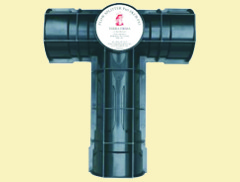 |
Home Profile Land Consulting Septic Services Products Testimonials Contact |
| Flowsplitter Press | A Nova Scotia invention fixes common environmental problem |
|
FLOWSPLITTER THE ULTIMATE SEPTIC TEE  NO MOVING PARTS MAINTENANCE FREE! See More >> PURCHASE FLOWSPLITTER HERE CALL TERRA FIRMA CONSULTANTS 902.576.3551 |
Wellington inventor provides solution for environmental snag Septic systems would become safer: an answer for a common environmental problem?
NEWS RELEASE, The Laker, August 2004 Nova Scotia invention fixes common environmental problem
Department of Environment & Labour International Study A major international study was conducted by the Department of Civil, Structural & Environmental Engineering at the University of Dublin in Ireland. This major international study tested numerous distribution devices for the ability to evenly split effluent in gravity-fed septic systems. Distribution boxes, stilling chambers, and splitter tees were all tested for the splitting efficiency under various conditions of off-level and varying degrees of steepness at the entry point to the splitting device. The distribution boxes and stilling chambers were very sensitive to minor off-level settings and were unsatisfactory. The splitting tees performed the best. And the splitting tee with the baffles was superior. The splitting tee with the baffles was Terra Firma's Flow Splitter®. The conclusion to the study summarized their findings by stating, "The laboratory trials using clean water shows that the Flow Splitter® device with the baffles showed the best flow splitting efficiency and was relatively insensitive to a range of off-level installation angles." |
||
|
|
|||
|
A
Comparison Between Distribution Devices used to Split
Laurence
Gill, Titiksh Patel, Niall O’Luanaigh Department of Civil, Structural & Environmental Engineering
University of Dublin,
Trinity College Abstract
A
rigorous site assessment is now required in Ireland in order to design an
on-site wastewater treatment system. A critical component of an effective gravity-operated on-site system is the distribution box, which must be able to promote an equal split of effluent between percolation trenches. Comparisons were made both in the laboratory using clean water and also on-site using a V-notch distribution box on two different types of wastewater effluent (septic tank and secondary treated). The trials carried out on distribution devices in the laboratory showed that flow distribution was sensitive to both the off level installation angles and variable flow rates.
The
flow regime experienced at distribution devices has been continuously
monitored using tipping bucket instrumentation over six month periods which
established that
Introduction
Poor
distribution of on-site wastewater effluent between subsoil percolation
trenches is often the cause of septic tank / soil percolation system
failures. Poor distribution results in hydraulic and biological overloading
of one or more of the percolation trenches. Even if the soil hydraulic
conductivity is adequate for transmitting the liquid away from the trenches,
the formation of a biomat may restrict wastewater percolation from the
trench (Van Cuyk et al., 2001). Hence, equal distribution of the effluent is
essential to prevent the failure of the system whereby all of the effluent
passes into one distribution line to the exclusion of the others. Equal
distribution to soil absorption components can be particularly difficult to
achieve when relying on gravity to promote such a split.
Conclusion
The
laboratory trials using clean water showed that the
Flow Splitter
device with baffles showed the best flow splitting efficiency and was
relatively insensitive to a range of off-level installation angles. In
contrast
the
stilling chamber design proved very sensitive to being off level and also to
different flow rates.
11th
Individual and Small Community Sewage Systems
20-24
October 2007 (Warwick, Rhode Island, USA) Publication Date: 20 October 2007 ASABE Publication Number 701P1107 |
|||
| Flowsplitter Applications Purchase Flowsplitter Here | |||
|
|
|||
 |
 |
 |
 |
|
Lot Approval Land Subdivision Development and Planning |
Septic Approvals Septic Replacement Design Custom Septic Design |
Flowsplitter Septic Tee
Septic Bed Liner Firma-Tex Geotextile |
Wetland Delineation Watercourse Alteration Buffer Zone Assessment |
|
|
|||
|
|
|
|
|
| Home Profile Land Consulting Septic Services Products Testimonials Contact | |||
 |
1 Pine Oak Dr Wellington, Nova Scotia B2T 1J4 |
Tel:
902.576.3551 Fax: 902.860.1663 info@terrafirmaconsultants.com www.terrafirmaconsultants.com |